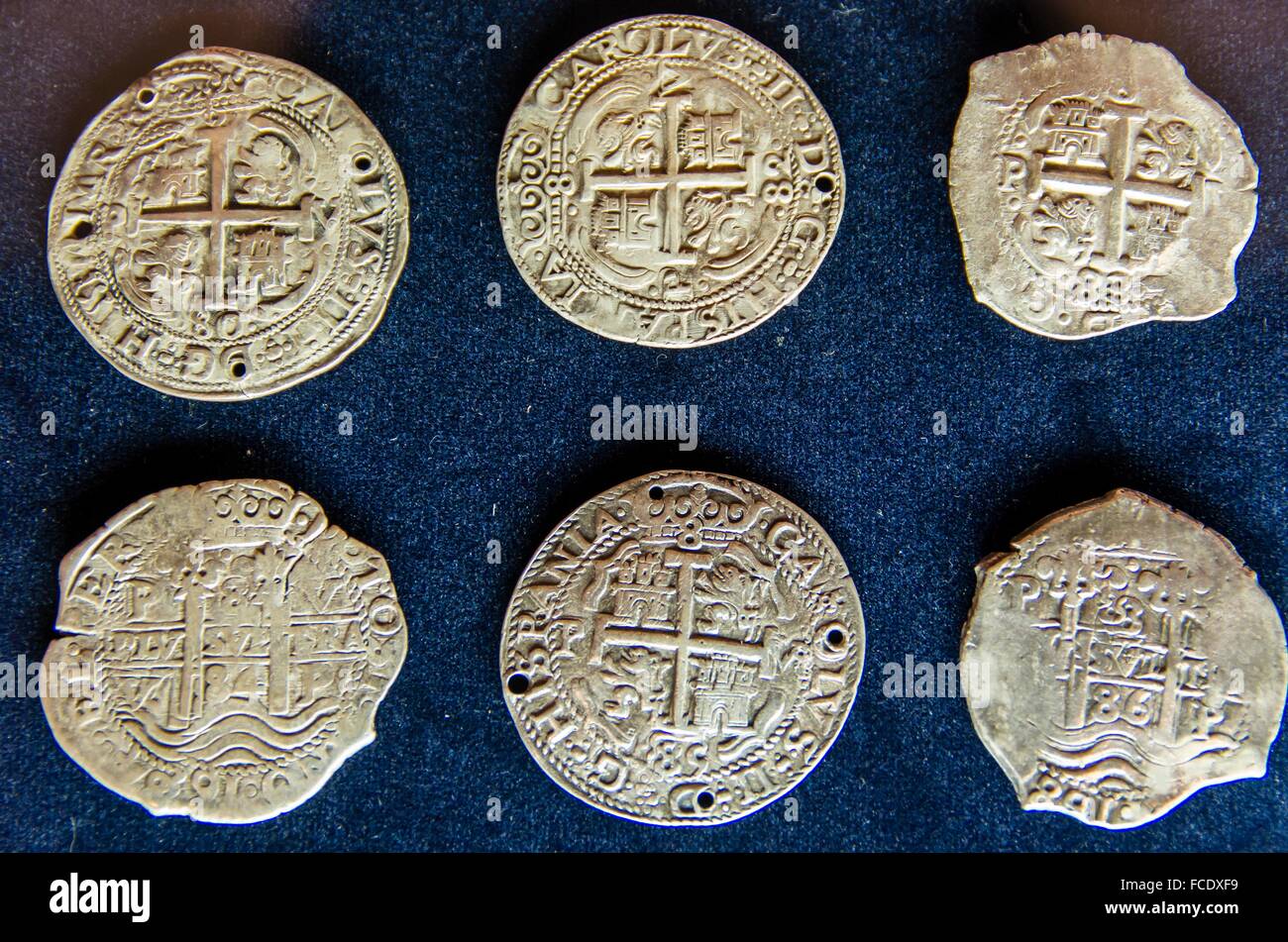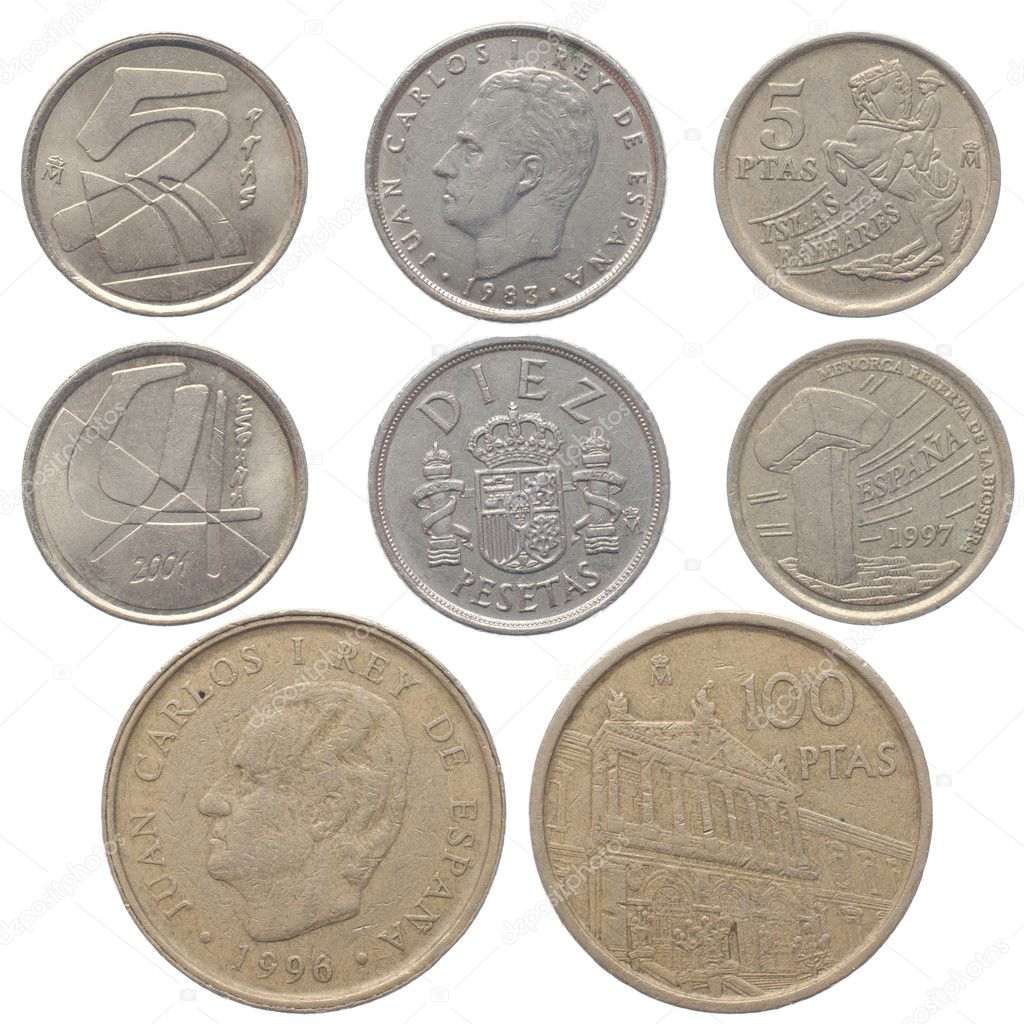Spanish Coins
Near the top of the coin the bottom of the E in REX is visible. The reverse bears the remains of the Jerusalem cross with the arms of Castile and Leon. The size of the cross indicates this coin was originally minted as a two reales coin, or possibly as a one real piece. Well before the great riches of the New World could be converted to coinage, as early as 1505 the mainland Spanish mints of Seville and Burgos began minting a series of silver and copper coins (now quite rare) specifically for delivery to and use in the colonies.

ONE-HALF REAL COBS
obverse | reverse | |
1/2 R Mexico Philip IV (1621-1665) cob
Obverse: . V . / P S / [quatrefoil]
Reverse: [no legible legend]
Weight: 15.8 g (1.02 grams) Diameter: 16.0 mm
Comments: The obverse give the monogram PVS with dots on eitherside of the superscript V and a quatrefoil below the monogram. The P andS are joined by a line extending from the bottom of the bow of the P throughthe center of the S. To the right of the P is part of the superscript Oin MO, the mintmark for Mexico. The border legend is worn away. On the reverseis a cross with the arms of Castile and Leon. Again the border legend iscompletely worn away. The shape of the cross with balls at the ends is uniqueto Mexico City. This specific design was minted by Philip IV (1621-1665),and is similar to the example found as item 4 on plate 3 in Alberto FranciscoPradeau,Numismatic History of Mexico from the Pre-Columbian epoch to1823, Pradeau: Los Angeles, 1938.
Provenance: From the Robert H. Gore, Jr. Numismatic Collection.
obverse | reverse | |
1/2 R West Indies clipped cob
Former Spanish Coins Crossword
Obverse: [R]E[X] [the remainder is obliterated]
Reverse: [legend off planchet]
Weight: 27.4 g (1.80 grams) Dimensions: 17.5 x 13.8 mm
Comments: The obverse of this extensively clipped cob is mostlyobliterated. To the far right there is a counterstamp (an oval depression)with a faint image of a star or pointed cross, most probably representinga West Indies counterstamp as from Montserrat, which at times used bothof these elements. Near the top of the coin the bottom of the E in REX isvisible. The reverse bears the remains of the Jerusalem cross with the armsof Castile and Leon. The size of the cross indicates this coin was originallyminted as a two reales coin, or possibly as a one real piece. However, throughclipping and mutilation it is now just slightly over the authorized weightfor the one half real (which is 1.69 grams). A full weight two reales wouldbe 6.77 grams and a one real should average 3.38 grams. Heavily clippedand defective pieces such as this circulated throughout the West Indiesand in Colonial America.
Provenance: From the Robert H. Gore, Jr. Numismatic Collection.
ONE REAL COBS
obverse | reverse | |

1 R Mexico AssayerO Philip II cob Mo-O between 1572-1598
Spanish Coins 1600s
Obverse: [PHILIPP]VS . II . DEI GRATIA
Reverse: [HISPANIARVM] . ET : INDIARVM [REX]
Weight: 44.5 g (2.88 grams) Diameter: 22.7 mm
Comments: This coin has been heavily clipped and is well belowthe authorized weight of 3.38 grams. Most of the upper potion of the legendletters has been clipped and in parts the entire legend is missing. Accordingto Pradeau (p. 42) there should be colons between each word. Although thiscoin is clipped it is better than the plated coin in Pradeau (plate 2, item5).
Obverse bears the crowned Hapsburg shield, to the feft is the mintmark'Mo' for Mexico City, while to the right is the assayer's initial 'O'. Accordingto Pellicer i Bru's, Glosario, p. 161 this unidentified assayer Owas active during the entire reign of Philip II 1556-1598. As this coinis a Mexican cob it cannot date to before 1572 when the dies used on thecobs first arrived in the New World. The reverse bears a cross with fleur-de-listransformed into balls at the ends, which is unique to the Mexico City mint.The Castile and Leon arms are completed with castles in the upper-left andlower-right quadrants and lions in the upper-right and lower-left quadrantsall surrounded in what in heraldic termonology is called a tressure (hererepresented by a border consisting of four arcs and four pointed sections).


Provenance: From the Robert H. Gore, Jr. Numismatic Collection.
obverse | reverse | |
1 R 1746 Potosí Assayer Q KM Bolivia 28a Philip V cob
Obverse: [no legible legend]
Reverse: the legend is in three rows, with each row divided intothree sections: top row: [all sections obscured]; second row: [leftsection obscured] VL TR third row: [left section obscured] 746 P
Weight: 47.1 g (3.05 grams) Diameter: 18 mm
Comments: The obverse and reverse designation for this coin issometimes confusing. On any coin of this period the side with the royalsymbol, either the ruler's shield, name or portrait was the obverse. Inthis case the obverse is the side with the Jerusalem cross with crossbarsat the ends and the Castile and Leon symbols, namely castles in the upper-leftand lower-right quadrants and lions in the upper-right and lower-left quadrants.Some books, as Sedwick, have mistakenly called this side the reverse. Thesituation is somewhat confusing for on earlier coins, like the Philip IIone real described above, the ruler's name and shield are on one side (whichwould make that side the obverse) while the Castile and Leon shield areon the the other (in such a case making it the reverse). In the presentsituation the Castile and Leon shield side is the only side with a royalsymbol making it the obverse!
The reverse actually gives more information about the coin. On this examplethe assayer's initial is obscured, but as the date and mintmark are visiblewe can assign the coin to the Potosíassayer Luis de Quintanilla (1744-60)who used the initial Q. (see see, Pellicer i Bru, Glosario, pp. 44and 175.) On the reverse the two vertical pillars, representing the Pillarsof Hercules, intersect three horizontal lines of text, giving the overallappearance of what is frequently called the 'tic tac-toe' design.The top line of text is obscured in this example but the top left squarewould include the mintmark P, the center square would have the denominationI while the right square would contain the assayer's initial Q. The centerline contains an abbreviated form of 'PLUS ULTRA' (More beyond).In this case the center left square is obscured but probably had PL or somecombination for PLUS. The center square has VL with TR in the square onthe right as an abbreviated form of ULTRA. The final line repeats some ofthe information on the top line but in reverse order and adds the date.The square on the left is obscured but would have contained the assayer'sinitial Q; the center box has the last three digits of the date 746 forthe year 1746 and the right hand box gives the mintmark P.
Provenance: Donated to Notre Dame in 1887 as part of a 2,300 itemcoin collection (see: The Notre Dame Scholastic, vol. 21 (September1887) 45.
| ' BORDER='0' ALIGN='BOTTOM' NATURALSIZEFLAG='3' WIDTH='107' HEIGHT='50'> | ||
| Charles and Johanna Coinage | Section Contents | Spanish Cobs: p.2 |

For viewing tips and information on optimal computer settings clickhere. For questions or comments contact Louis Jordan by: |
he Spanish Doubloon was a seven-gram (.225 Troy-ounce) gold coin minted in Spain, Mexico, and the Spanish settlement of Nueva Grenada (present-day Peru) that was used widely in the Americas until the mid-nineteenth century. The word “doubloon” has its roots in the Latin word “duplus,” meaning double, a reference to denomination of this coin worth two escudos. These gold coins were eventually minted in four denominations, worth one, two, four, and eight escudos respectively.
Throughout the 16th and 17th centuries, gold doubloons played a pivotal role in the Spanish economy and were a major part of its colonial activities. Doubloons minted in the Americas were carried on Spanish galleons throughout the Caribbean and across the world to trade for highly sought after commodities such as silks and spices. As they made their way across the vast seas and oceans, the captains of these ships were always wary of attack from marauding pirates. The pirates knew full well that if they could manage to intercept a Spanish galleon en route to its trading destination, their chances of finding gold aboard were extremely high.
Doubloon Design
Minted on the front of the doubloon is the coat of arms of the Hapsburg royal family, known as the “Hapsburg Shield.” Ferdinand and Isabella of Spain, remembered by history as the king and queen who launched the voyage of Christopher Columbus, were part of the Hapsburg royal lineage. The “Crusader’s Cross” is stamped on the coin's reverse. The appearance of this symbol indicates the close tie between religion and government in Spain in the 16th and 17th century. The doubloon’s reverse also contains a lion, representing the Spanish province of Leon and a castle, the symbol of the province of Castile.